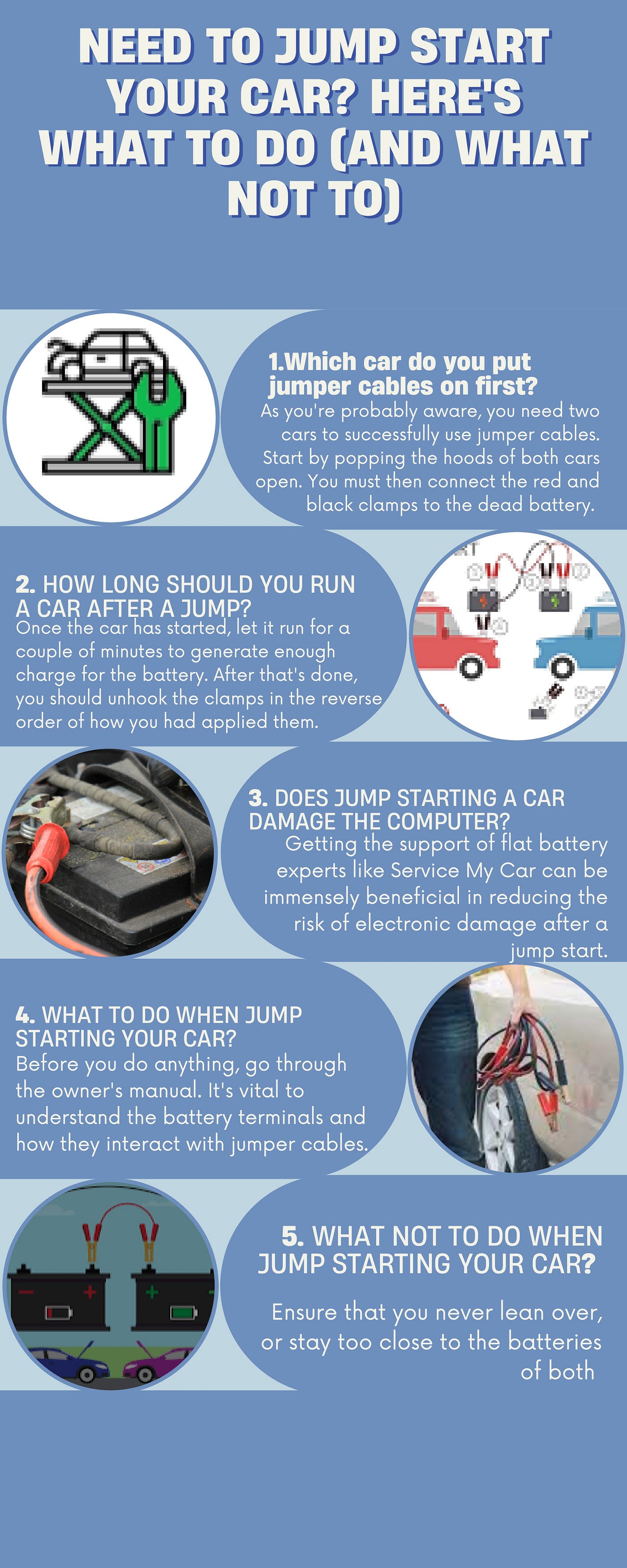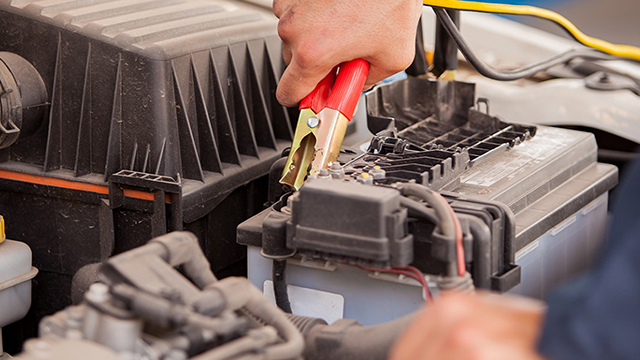Jump-starting a car can potentially damage the battery due to the sudden surge of power. However, if done correctly, it usually does not cause harm.
It’s essential to follow proper procedures to minimize the risk of damaging the battery when jump-starting a car. When jump-starting a vehicle, the sudden rush of power from the donor battery to the dead battery can potentially cause damage. However, if the process is carried out following the correct steps, it generally does not harm the battery.
To avoid any potential damage, it’s crucial to ensure the cables are connected correctly and to allow the donor car to run for a few minutes to charge the dead battery. By following these precautions, jump-starting a car can be a safe and effective way to get back on the road.

Credit: medium.com
Understanding Car Batteries
Function Of A Car Battery
A car battery is the heart of a vehicle’s electrical system, providing the necessary power to start the engine.
- Battery stores and releases electrical energy.
- Supplies power to various components such as lights and radio.
Signs Of A Weak Car Battery
Recognizing signs of a weak car battery is crucial to avoid unexpected breakdowns.
- Slow engine cranking when starting the car.
- Dimming headlights and interior lights.
- Frequent need to jump-start the vehicle.
Jump-starting a car can cause damage when done improperly, risking harm to the battery and other components.
The Jump-starting Process
Jump-starting a car can be a lifesaver when you find yourself with a dead battery and no other immediate options. However, it is important to understand the correct process to avoid any potential damage to your battery or electrical system. In this section, we will outline the steps to jump-start a car safely and the dos and don’ts that you need to keep in mind.
Steps To Jump-start A Car Safely
- Ensure both cars are in park or neutral and turned off. Put on safety gloves and goggles.
- Locate the battery on both cars. Identify the positive (+) and negative (-) terminals.
- Securely attach one end of the red jumper cable to the positive (+) terminal of the battery in the dead car.
- Connect the other end of the red jumper cable to the positive (+) terminal of the working car’s battery.
- Take the black jumper cable and attach one end to the negative (-) terminal of the working car’s battery.
- Find an unpainted metal surface in the engine bay of the dead car. Attach the remaining end of the black jumper cable to this surface, ensuring a good metal-to-metal connection.
- Start the working car’s engine and let it run for a few minutes to charge the dead battery.
- Attempt to start the dead car. If it doesn’t start, try letting the working car run for a few more minutes before attempting again.
- Once the dead car starts, remove the jumper cables in reverse order, starting with the black cable from the engine bay of the dead car, followed by the black cable from the working car’s battery, the red cable from the working car’s battery, and finally the red cable from the dead car’s battery.
Dos And Don’ts Of Jump-starting A Car
While jump-starting a car can be an effective solution, there are some dos and don’ts that you should adhere to in order to avoid causing any damage:
Dos:
- Do wear safety gloves and goggles to protect yourself from any potential sparks or acid
- Do ensure both cars are turned off and in park or neutral
- Do make sure to connect the positive terminal (+) to the positive terminal (+) and the negative terminal (-) to an unpainted metal surface
- Do let the working car run for a few minutes to charge the dead battery before attempting to start the dead car
- Do remove the jumper cables in reverse order to avoid sparks or electric shock
Don’ts:
- Don’t let the jumper cables touch each other or any metal surfaces other than the designated terminal
- Don’t try to jump-start a car with obvious damage to the battery or electrical system
- Don’t attempt to jump-start a hybrid or electric vehicle unless you have proper knowledge and experience
- Don’t keep the cars connected for too long after the dead car starts, as it may put strain on the electrical systems
By following these steps and keeping these dos and don’ts in mind, you can safely jump-start your car without causing any damage to your battery or electrical system.
Potential Risks
When jump-starting a car, there are potential risks that should be considered to avoid damaging the battery or causing other serious issues. Understanding these risks can help car owners take the necessary precautions to prevent any damage.
Electrical Damage
Jump-starting a car improperly can lead to electrical damage. Connecting the jumper cables incorrectly or using an inappropriate power source can result in a surge of electricity that could harm the car’s sensitive electrical components, such as the alternator and on-board computer.
Battery Explosions
Incorrect jump-starting procedures can also increase the risk of battery explosions. When the jumper cables are not connected properly, it can cause an overload of current, leading to the release of flammable gases from the battery. This can result in a dangerous explosion, posing a risk of injury to anyone in the vicinity.
Preventive Measures
Preventing damage to your car battery is crucial for ensuring its longevity and optimal performance. By taking some preventive measures, you can effectively avoid potential harm to your battery when jump-starting your car.
Regular Battery Maintenance
Regular battery maintenance is essential for preventing damage when jump-starting your car. Make sure to clean the battery terminals regularly to prevent corrosion and ensure a strong connection. Check the battery’s water level if it is a non-sealed lead-acid battery and top it up if needed to avoid excessive strain during jump-starts.
Using A Portable Jump Starter
Portable jump starters are a convenient and safer alternative to traditional jump-starting methods. They come with built-in safety features and prevent over-voltage from damaging your car’s battery. Additionally, they eliminate the need for another vehicle, reducing the risk of improper connections and potential damage.
Impact On Modern Vehicles
Can Jump-Starting a Car Damage the Battery? Absolutely! But what about the impact on modern vehicles? Let’s delve deeper into the effects on electronic systems and consider the recommendations from auto manufacturers.
Effects On Electronic Systems
Jump-starting a car can potentially have adverse effects on the electronic systems of modern vehicles. The sudden surge of electrical power when jump-starting can disrupt the delicate balance of these systems, leading to malfunctions and even permanent damage. The sensitive onboard computer systems, including the engine control unit (ECU), infotainment system, and advanced driver-assistance systems (ADAS), are particularly vulnerable to such power fluctuations.
Additionally, certain electronic components like the vehicle’s alternator or voltage regulator might not be designed to handle the sudden high current flow during a jump-start. This excessive electrical load can strain these components, potentially causing voltage spikes that could damage the sensitive electronic circuits within the vehicle.
Recommendations From Auto Manufacturers
Auto manufacturers strongly discourage jump-starting a vehicle unless absolutely necessary, as they recognize the potential risks involved. Instead, they recommend following a few alternative strategies:
- Use a battery charger: If the battery is dead, using a battery charger to slowly recharge it is the safest and most preferred option. This avoids sudden power surges that can harm the electronic systems.
- Seek professional assistance: If you are unsure how to handle a dead battery, it is best to contact a professional towing service or an automotive technician. They have the expertise and equipment to safely jump-start or replace the battery without causing any damage.
- Maintain regular battery maintenance: Regularly checking the battery’s condition and ensuring proper maintenance can help prevent dead batteries. This includes cleaning terminals, tightening connections, and inspecting for any signs of corrosion or other damage.
Remember, prevention is always better than cure. Taking proactive measures to maintain the health of your car’s battery can help avoid the need for jump-starting and potential damage to the electronic systems.

Credit: www.mynrma.com.au
Debunking Myths
Debunking Myths: Can Jump-Starting a Car Damage the Battery?
Myth: Jump-starting Always Damages The Battery
Fact: While jump-starting can temporarily strain the battery, proper procedures minimize the risk.
Common Misconceptions
- Jump-starting is always harmful to the battery.
- A quick jump-start will fully charge a dead battery.
- Any vehicle can be used to jump-start another.
Jump-starting a car, when done correctly, is a safe method to restart a vehicle with a depleted battery.

Credit: www.citizen.co.za
Conclusion
To sum it up, jump-starting a car can indeed pose a risk to the battery, but with proper precautions, it can be done safely. It’s important to follow the correct procedure, ensuring that the cables are properly connected and the correct voltage is used.
Regular maintenance and a well-maintained battery can also reduce the chances of damage. By considering these factors, you can safely jump-start a car without harming the battery.


